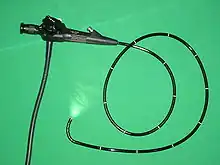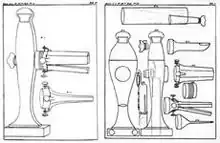Endoscope


An endoscope is an illuminated optical, typically slender and tubular instrument (a type of borescope) used to look deep into the body by way of openings such as the mouth or anus, and used in procedures called an endoscopy. Endoscopes use tubes which are only a few millimeters thick to transfer illumination in one direction and high-resolution images in real time in the other direction, resulting in minimally invasive surgeries.[1] "Endo" is Greek for "within" while "scope" comes from the Greek word "skopos" meaning to target or look out. It is used to examine the internal organs like the throat or esophagus. Specialized instruments are named after their target organ. Examples include the cystoscope (bladder), nephroscope (kidney), bronchoscope (bronchus), arthroscope (joints) and colonoscope (colon), and laparoscope (abdomen or pelvis).[2] They can be used to examine visually and diagnose, or assist in surgery such as an arthroscopy.
For non-medical uses, similar instruments are called borescopes. In recent times electronic borescopes have become widely and cheaply (~$10) available and are often advertised as endoscopes.
The first effective open-tube endoscope was developed in 1853 by Desormeaux. This instrument was used to examine the urethra and the bladder Then, in the late 1800s, other physicians including Kussmaul and Nitze refined original endoscopic models and began these prototypes to be used for medical use.
References
- ↑ Süptitz Wenko, and Sophie Heimes. Photonics: Technical Applications of Light: Infographics. Spectaris GmbH, 2016.
- ↑ "Medical Definition of Endoscope". Medicinenet.com. Retrieved 11 August 2017.
External links